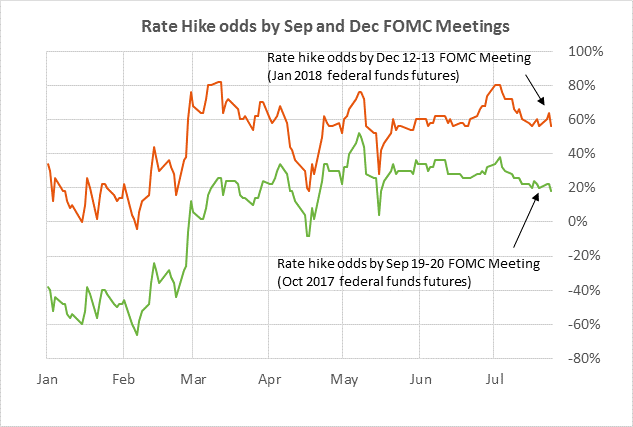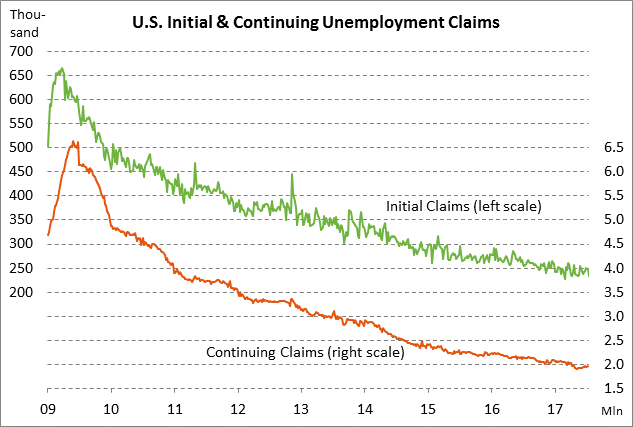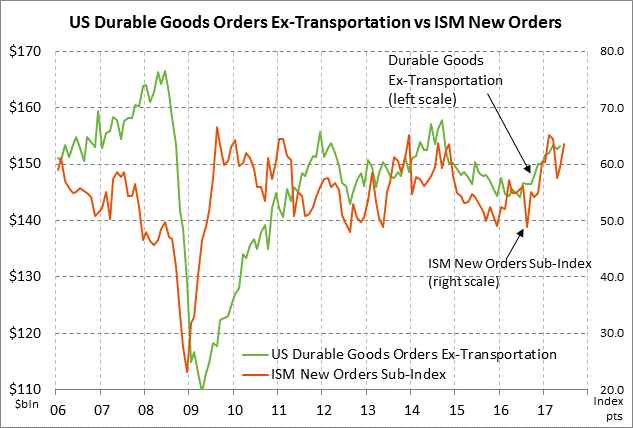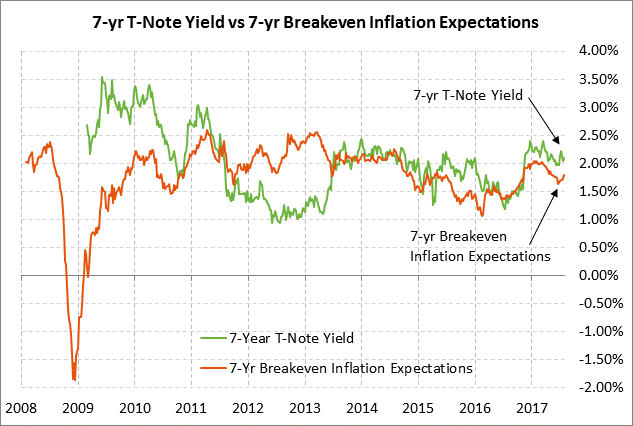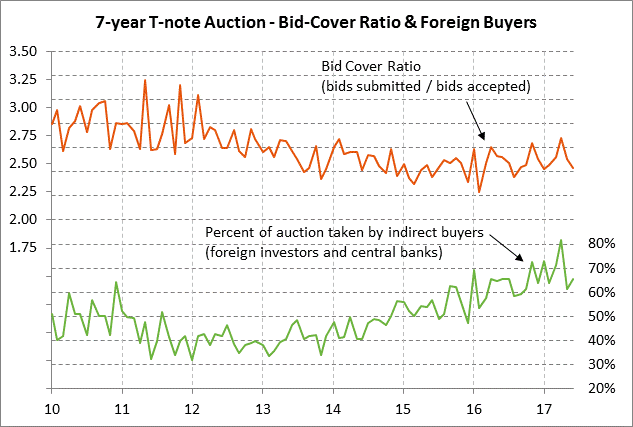- Tax reform principles expected to be released by Friday
- FOMC meeting concludes with dovish outcome
- U.S. unemployment claims continue to point to strong U.S. labor market
- U.S. durable goods orders report is expected to support strong manufacturing confidence
- 7-year T-note auction to yield near 2.10%
Tax reform principles expected to be released by Friday — Politico reported on Wednesday that a unified Congressional-White House tax reform framework will be released by Friday afternoon before the House leaves for its recess. The details of the plan could emerge sooner once a final agreement has been reached. It remains to be seen how detailed the proposal will be. Republican leaders are mainly trying to get a messaging document out to their members to help them push for tax reform during the August recess.
The main item of interest for the stock market will be how far the Republicans plan to cut the corporate tax rate. President Trump has long pitched a 15% rate but there were reports out of the White House last week that the discussions now center on the 20-25% area. That would still be a big improvement from the current top corporate tax rate of 35%, the highest in the developed world, and would be close to corporate tax rates in most other countries. The markets are also very interested in the fate of the border adjustment tax, deductibility of interest, and the terms for repatriation of overseas corporate cash.
FOMC meeting concludes with dovish outcome — The post-meeting statement from the Tue/Wed FOMC meeting said that it would begin implementing its balance sheet normalization program “relatively soon.” The market took that as a signal that the announcement will likely come at the next meeting on Sep 19-20, which was the market consensus before this week’s meeting.
The fact that the FOMC yesterday did not announce an exact start date could be taken as a dovish sign that the Fed is keeping its options open about when it will start reducing its balance sheet. In addition, the Fed said the program would be implemented “relatively” soon, which could mean later than the next FOMC meeting. Sep 10-year T-note futures prices rallied by about 10 ticks after the the FOMC results were released. The federal funds futures curve turned more dovish by 1 bp for late-2017 and 3-5 bp for the 2018-19 contracts.
By waiting until September, the FOMC can see two more months worth of economic and inflation data and can also gauge the political situation in Washington. The FOMC cannot start its balance sheet normalization program until Congress raises the debt ceiling and that may not occur until the deadline of early to mid-October.
The FOMC on Wednesday left its funds rate target unchanged at 1.00-1.25%, which was in line with unanimous market expectations. The implied odds for the Fed’s next rate hike are at 18% for the next FOMC meeting on Sep 19-20, 20% by the Oct 31/Nov 1 meeting, and 58% by the Dec 12-13 meeting. We believe that the Fed will be leaning strongly towards a rate hike in December so it can make good on its forecast for three rate hikes in 2017.
U.S. unemployment claims continue to point to strong U.S. labor market — The initial and continuing unemployment claims series both remain near decade-plus lows, indicating a strong labor market where businesses are holding on tightly to their current employees. The initial claims series is only +6,000 above the 44-year low of 227,000 posted in February, while the continuing claims series is +78,000 above its 29-year low of 1.899 million posted in May.
The market consensus is for today’s weekly initial unemployment claims report to show a +7,000 increase to 240,000 following last week’s -15,000 decline to 233,000. Continuing claims are expected to show a decline of -18,000 to 1.959 million following last week’s +28,000 increase to 1.977 million. After some shaky payroll data during the spring, the payroll data is again showing solid hiring with a 3-month average monthly increase (in Apr-Jun) of +194,000.
U.S. durable goods orders report is expected to support strong manufacturing confidence — The market consensus is for today’s June durable goods orders report to show a strong overall increase of +3.5% but only a small +0.4% increase ex-transportation. That would be an improvement from May’s report of -0.8% and +0.3% ex-transportation. The consensus is for June capital goods orders ex defense and aircraft, a proxy for corporate capital spending, to show just a small +0.3% increase after May’s +0.2% report.
Durable goods orders ex-transportation in general remain strong with a year-on-year increase of +5.8% y/y in May. That is consistent with the strong June ISM manufacturing new orders sub-index of +4.0 points to 63.5, which is just mildly below February’s 8-year high of 65.1. Manufacturing confidence in general remains strong with the ISM manufacturing index in June rising by +2.9 points to a 2-3/4 year high of 57.8.
7-year T-note auction to yield near 2.10% — The Treasury today will conclude this week’s $103 billion T-note package by selling $28 billion of 7-year T-notes. Today’s 7-year T-note issue was trading at 2.10% in when-issued trading late Wednesday afternoon. That translates to an inflation-adjusted yield of 0.31% against the current breakeven 7-year inflation expectations rate of 1.79%.
The 12-auction averages for the 7-year are as follows: 2.53 bid cover ratio, $12 million in non-competitive bids to mostly retail investors, 4.5 bp tail to the median yield, 19.6 bp tail to the low yield, and 41% taken at the high yield. The 7-year is tied with the 30-year TIPS as the second most popular security among foreign investors and central banks behind the first-place 10-year TIPS. Indirect bidders, a proxy for foreign buyers, have taken an average of 66.5% of the last twelve 7-year T-note auctions, which is well above average of 60.2% for all recent Treasury coupon auctions.

